Leave Laxe and head off towards Ponteceso, when you reach the crossroads at As Agrelas, turn right towards Baio and once you reach the roundabout at Borneiro, turn right towards the dolmen of Dombate. This prehistoric monument is the most famous one in Galicia and is regarded as a cathedral of megalithic architecture in the region. It had already awakened the curiosity of the historian Manuel Murguía and the poet Eduardo Pondal in the 19th c. passed by the dolmen on his way from Nemiña and immortalised it in one of his poems.
(…) I left Fontefría and set off towards Laxe on the road of San Simón de Nande, in the region Borneiro, full of small pines, and passed by the dolmen of Dombate (…)
E. Pondal
The tumulus is made of earth and has a stone enclosure. The structure consists of seven vertical slabs (orthostats), a ceiling and the entrance corridor, which was hardly visible until the most recent excavations of 1987-1989, directed by the archaeologist José Maria Bello Diéguez. They found that the corridor was made up of three sections of orthostats and the entrance was closed off with a vertical stone. The most surprising finds, however, were the etchings found on some slabs and traces of paintings of paintings in the chamber and corridor. A previous dolmen was also discovered underneath the shell that was later called “old Dombate”. It was made up of one single chamber and only one of the stones of the chamber was found.
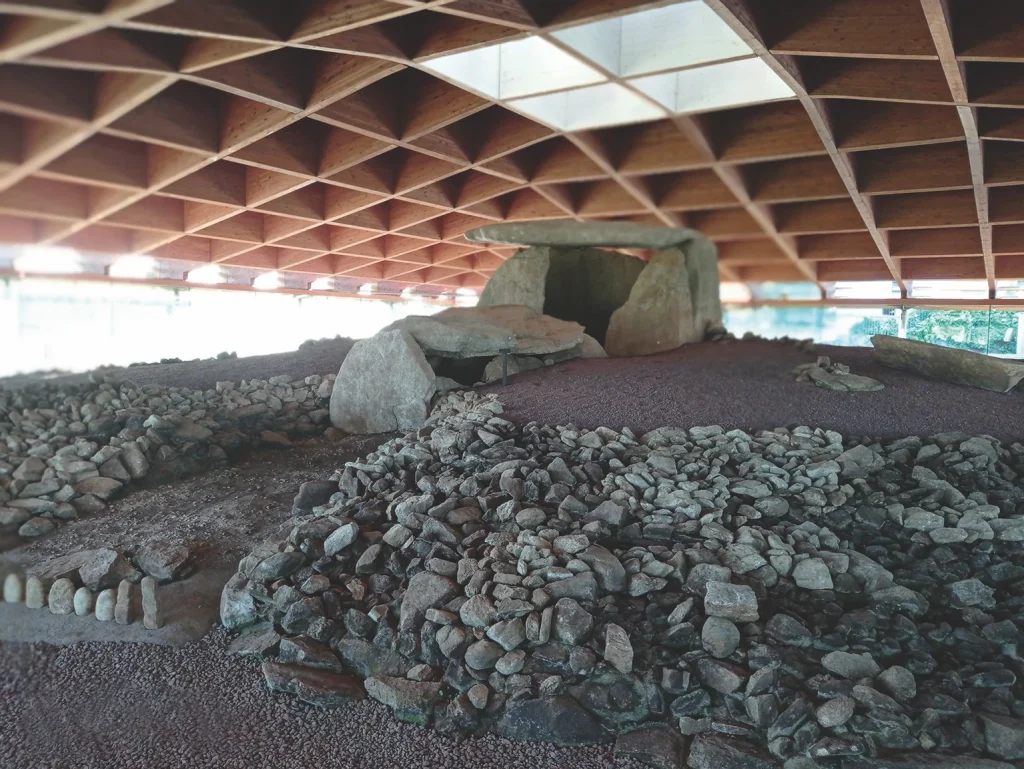
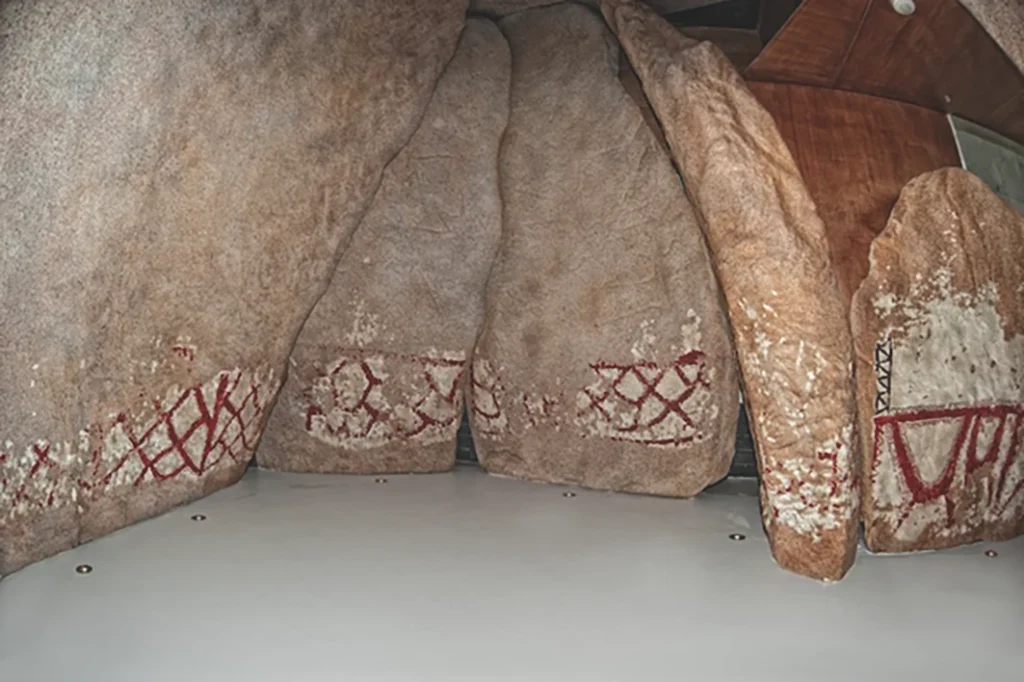
A line of twenty idoliños (small stone figures with rudimentary human forms) were found in front of the entrance to the corridor of “recent Dombate”; others had already been found in dolmens of this type.
Different objects were found in the subsoil of the monument: arrow heads, flint blades, axe heads, beads, grindstones and different types of pre-bell beaker and bell beaker pottery.
After the paintings were discovered, the monument was provisionally protected with a plastic sheet until 2011, when the structure covering the entire complex was completed. A visitor reception centre was also built, including a replica of the dolmen, the etchings and paintings. Access to the original monument is now prohibited.
Take the same road to leave the dolmen of Dombate and when you reach the roundabout, go left towards Ponteceso. A short distance away on the right is the visitors car park for the castro of A Cidá de Borneiro, an Iron Age settlement to the north of O Chan de Borneiro, on a slope that descends to the stream of Os Muíños. The settlement is elliptical and measures 90 m in length by 55 m in width. It is regarded as a medium-sized castro.
The high ground of the castro is protected by a double wall and a ditch, except for the east side with just one wall due to the steep slope. The main entrance to the settlement is on this side.
It was the first castro to be dated with C-14 techniques in Galicia. The data obtained showed that settlement began in 524 BCE and continued until the 1st c. CE.
The first references to the castro appear in studies by Salvador Parga Pondal and Pérez Bustamante in 1924. The first archaeological excavation of the site took place in the next decade under the direction of Sebastián González. Jorge Juan Eirora continued to study the site in the sixties, while the historian Ana Romero Masiá conducted the most extensive excavations in the 1980s. Almost three quarters of the settlement were excavated and brought to light 36 structures, most of which were dwellings, however other buildings were found that may have been used for the economic activities of the settlement.
The structures were mostly circular, but other rectangular buildings with curved corners were also found. One curious feature of the buildings is the lack of any entrances, which may be because they were placed at a higher point in the wall. The centre of each dwelling is a fireplace marked out by embedded slabs to prevent the wooden post that bore the weight of the roof from being burned.
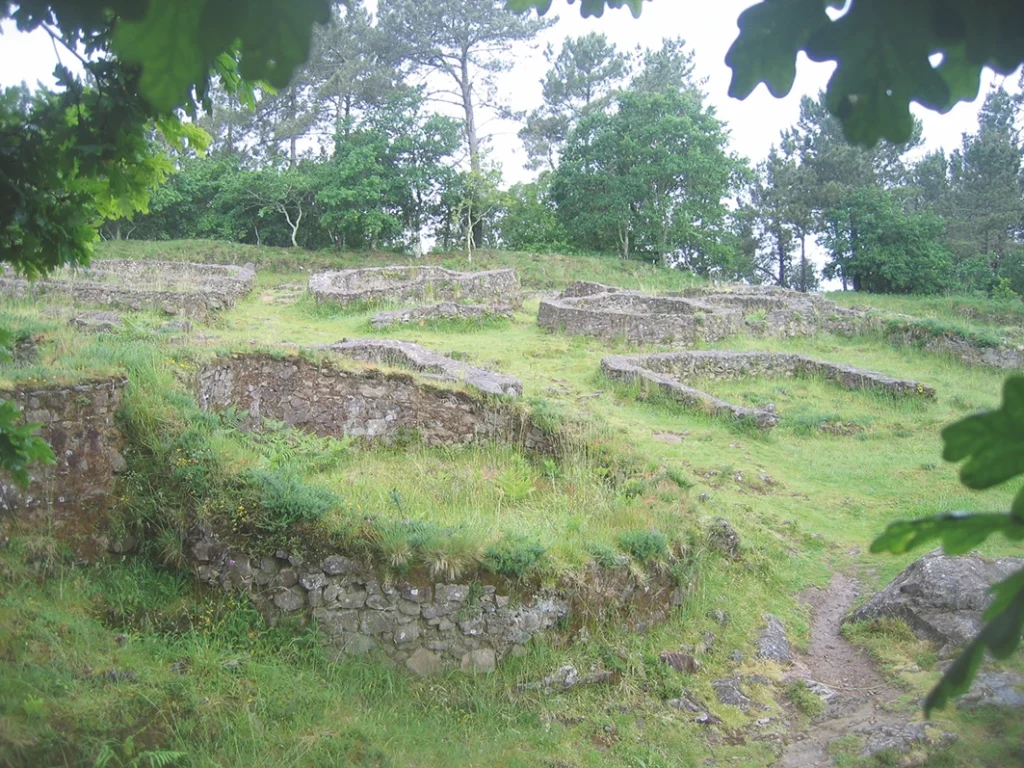
An area called the Barrio Extramuros (outer district) was discovered on the east side of the castro, which included a large elliptical structure, a spring with a drain and another structure with an oven or kiln. Theories about this building range from it being a sauna to an area for forging metal.
Many objects were found during the excavations, especially in the most recent one. These include stone objects such as flat grindstones, sharpening stones, casting moulds, spindle whorls and polished axe heads. Many highly fragmented potsherds were also found, which indicates that the inhabitants abandoned the castro peacefully. The remains include mugs, pots and jars, painted red or yellow and decorated using different techniques and patterns. A lot of bronze and iron objects were also discovered: needles, rings, fíbulae, knives, daggers, sickles, etc. Most of these objects are on display at the Historical and Archaeological Museum at the Castle of Santo Antón in A Coruña.
When you leave the castro, take the road that goes down to the crossing with As Agrelas and once you’re there head towards Ponteceso. The road now borders the left side of the estuary of the river Anllóns and there you can see some beautiful views of Monte Branco and the natural space of the estuary, which is is exceptional in ecological terms for the large number of birds that nest there along with the many migratory species that rest in the estuary. An ideal space for bird lovers.
Pass through A Carballa, where you’ll see the Casa do Concello (town hall) of Cabana de Bergantiños, and Neaño, the largest village in the municipality. When you cross the bridge over the river Anllóns, you enter Ponteceso, the capital of the municipality of the same name. It is most famous for being the birthplace of the poet Eduardo Pondal (1835-1917), one of the great writers during the resurgence of Galician literature and author of the lyrics to the Galician national anthem. His childhood home can be seen next to the river, a large stone building with a a gallery and large grounds with a fence. Pondal was always proud of having been born here. He said as much in his poetry:
(…) I was not born in a city or town, I was born far from their enticing murmur; I was born next to a thick pine grove, I was born in little Ponteceso (…).
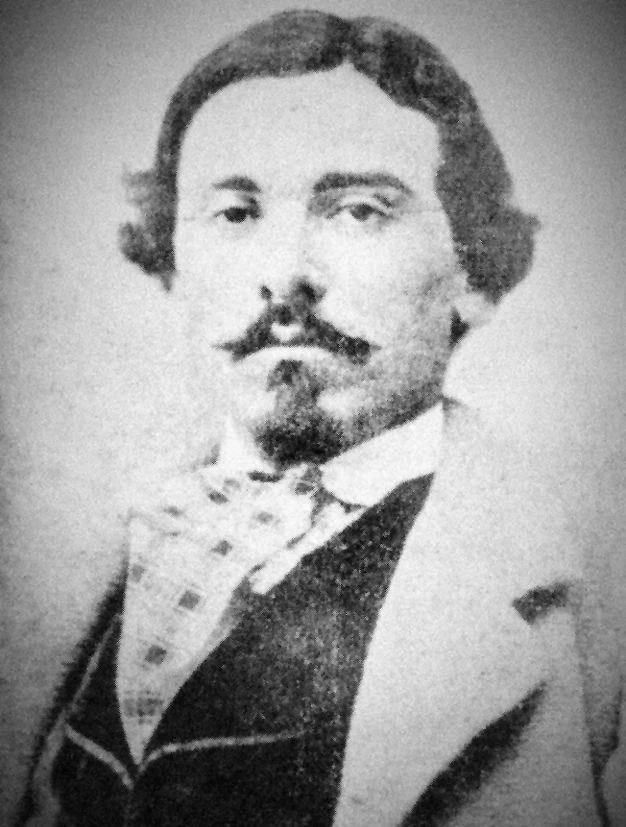
Influenced by the historians of his time (Murguía and Vicetto), he invented a world of myth peopled with hypothetical Celtic heroes taken from place names in the area and the rest of Costa da Morte and created a glorious past to justify a regionalist Galicianist philosophy.
Ponteceso came about from the union of small hamlets that existed at both ends, linked by the avenue named after the poet that crosses the old wetlands at the mouth of the river Anllóns.
On the east side is A Trabe, which grew thanks to the fair that was transferred from the nearby parish of Anllóns; on the the west side is the small village of Ponteceso that grew around the bridge, which was a place of transit and included a nearby jetty from which timber, farm produce and pottery from Buño was exported.
After crossing the bridge, turn left towards Corme. Pass through the hamlet of O Couto, well known for being home to the Monte Branco association and the Eduardo Pondal foundation, two cultural associations that are especially especially active during the Galician Literature Day.
After O Couto you’ll come to a diversion to the left that takes you to the top of Monte Branco (182 m) and the beach of Balarés. From here you’ll have some of the best views of the mouth of the river Anllóns and the ría of Corme and Laxe. Well worth a visit. The beach of Balarés is a very cosy spot thanks to its white sands, its location where it is protected from the winds and because of the large pine forest that surrounds it.
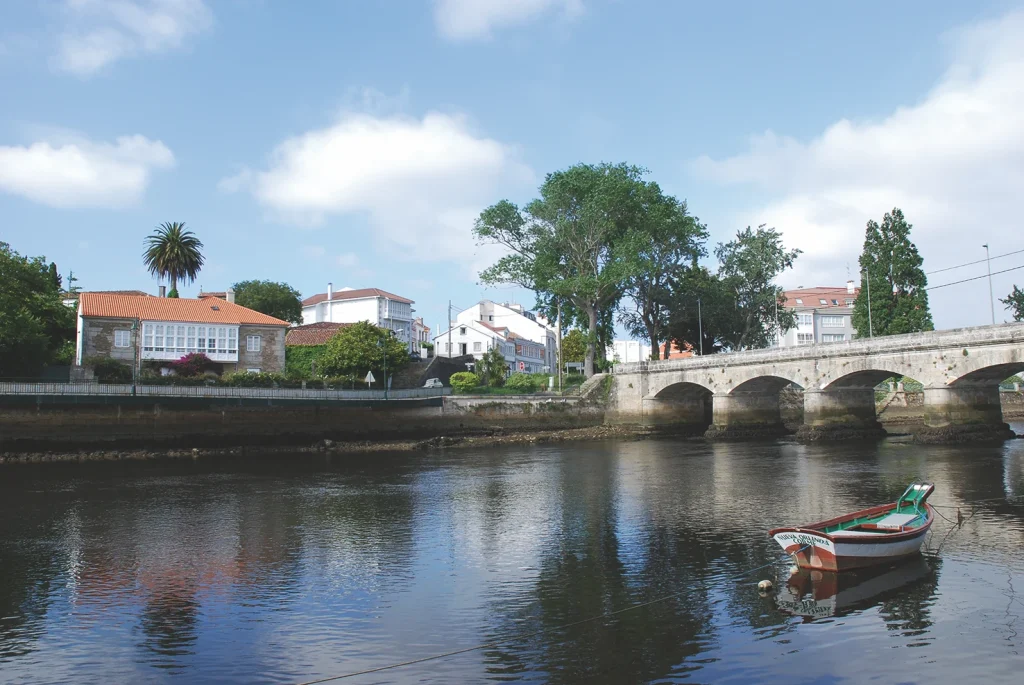
Continue on to Corme. Before you reach the town, you’ll come to Corme Aldea. The word “aldea” means hamlet, and indicates that the old farming community around which the parish grew had its origins here.